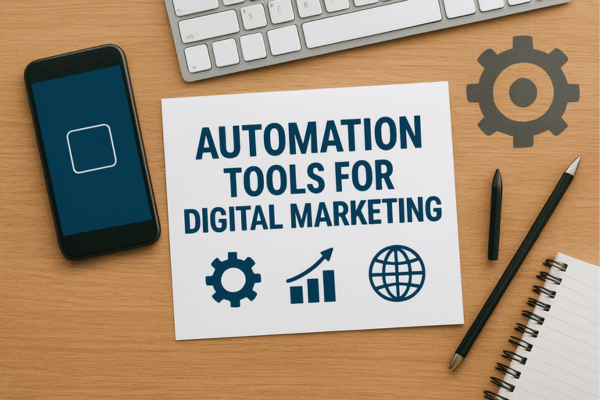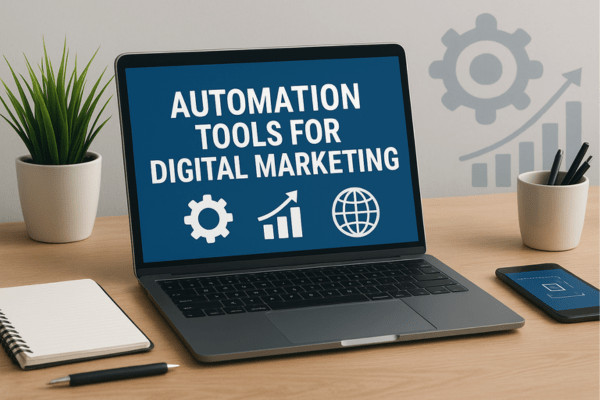In the world of digital marketing, one resource you have to be cautious with is time. Campaigns require optimization, content needs to be distributed, and audiences need to be engaged, quite often all at the same time. For digital marketers doing all of this, burnout and missing opportunities can happen quickly. The answer is to implement Automation Tools for Digital Marketing strategically.
These aren’t merely flashy and frivolous gadgets; they are powerful allies in organizing workflows, thus freeing hours and improving the effectiveness of your marketing campaigns many times over. The right Automation Tools for Digital Marketing can change the way you work – shifting your mindset away from tedious tasks to things like strategy and creativity – from social media scheduling to personalization of email communications.
The Irresistible Power of Marketing Automation
Picture gaining back hours each week, minimizing mistakes, and instilling a sense of urgency into every single interaction with a customer – not to mention, having it personalized. This is not a dream; it is the power of Automation Tools for Digital Marketing. In a thoroughly competitive environment, manual processes won’t suffice. Automation allows you to scale your marketing without expanding your team, provide a consistent brand experience to your customers, and collect meaningful data to optimize your campaigns. Digital marketers need to understand and leverage the Automation Tools for Digital Marketing to survive and grow, not as a choice.
Your Content Calendar’s Best Friend: Social Media Automation Tools
It can be a full-time job to manage several social media channels simultaneously. That’s where social media Automation Tools for Digital Marketing are helpful. They let you schedule posts ahead of time, multi-post from one dashboard, and quickly analyze performance.
- Buffer/Hootsuite/Sprout Social: Schedule posts across several platforms, monitor mentions, and run analytics.
- Tailwind: Specific to Pinterest and Instagram, this tool will curate your content and offer smart scheduling.
- Later: Visually plan, schedule, and design Instagram posts, Stories, and Reels.
These tools provide consistent and engaging social presence without your constant control – that’s what makes them Automated Tools for Digital Marketing.
Building Bridges: Email Marketing Automation Tools

Email marketing automation is one of the oldest and most effective categories of Automation Tools for Digital Marketing. It elevates from impersonal email blasts into communication journeys that are custom and personal.
- Mailchimp/ConvertKit/ActiveCampaign: Create welcome sequences, reminders about an abandoned cart, and re-engagement campaigns, and segment your audience by what they do.
- Automated Drip Campaigns: Automatically deliver a series of emails over time to leads.
- Behavioral Triggers: Send a specific email based on a behavior (i.e., downloaded an e-book or visited a product page).
These Content Tools for Digital Marketing will lead to higher open rates, click-throughs, and conversions because they deploy the right content to the right person at the right time.
Streamline Your Sales Funnel: Marketing Automation Platforms (MAPs)
For more complex funnels and larger organizations, Marketing Automation Platforms (MAPs) are integrated suites of Automation Tools for Digital Marketing that connect various aspects of your marketing.
- HubSpot/Marketo/Pardot: These platforms combine email marketing, lead nurturing, CRM integration, landing page creation, and analytics into one cohesive system.
- Lead Scoring: Automatically score leads based on their engagement and demographic data, helping sales teams prioritize.
- Workflow Automation: Create complex multi-channel customer journeys that trigger actions based on user behavior across email, website, and CRM.
MAPs are incredibly powerful Automation Tools for Digital Marketing for businesses looking to scale their operations.
Supercharge Your SEO with Automation Tools for Digital Marketing
Although quality content and backlinks are paramount, many facets of SEO can be greatly automated by Automation Tools for Digital Marketing.
- Keyword Research Tools (e.g, Ahrefs, SEMrush): Automate competitive analysis, monitor SERP rankings, and discover new target keywords.
- Technical SEO Crawlers (e.g, Screaming Frog): Evaluate broken links, crawl errors, and other technical aspects that affect your website’s health much more quickly.
- Content Optimization Tools (e.g. Surfer SEO): Review your competition’s content for the top-ranking pages and provide suggestions for your own content, which will allow you to generate optimized content for SEO much more quickly.
These Automation Tools for Digital Marketing can help you monitor, analyze, and optimize your website much more easily and without constantly doing it manually.
Crafting Engaging Ads: PPC Automation Tools
Overseeing Pay-Per-Click (PPC) campaigns can be very time-consuming, especially with large accounts. PPC Automation Tools for Digital Marketing is capable of handling the repetitive tasks and optimizing bids for you.
- Google Ads Automation Rules: Automation rules that you can set up to effectively, automatically adjust the campaign bids as performance metrics change or upon completion of a campaign, with alerts.
- Third-Party Bid Management Tools (Optmyzr, WordStream, etc.): The software will allow more sophisticated bid strategies, budget allocation, and reporting.
- Ad copy generators: AI-generated tools can quickly help you generate tens or hundreds of different ad copy variations.
They will all be critical Automation Tools for Digital Marketing to help you utilize your advertising budget to the fullest.
Customer Relationship Management (CRM) Automation
On one side, these tools are definitely thought of as tools related to sales. On the other side, CRM Automation Tools for Digital Marketing are necessary for marketing teams that need to keep track of customer engagements, and it’s easier to connect and engage with your customers.
- Salesforce/Zoho CRM: Track client interactions, organize audience segments, and integrate with marketing automation to personalize engagement.
- Automated Follow-ups: Imagine how easy it would be for your sales team to get the tasks and emails you designed for them to automate based on the marketing engagement.
- Lead Handoffs: Facilitate timed transitions of qualified leads from marketing to sales, without losing out on opportunity.
A well-integrated CRM is the foundation for your broader Automation Tools for Digital Marketing arsenal.
Analytics & Reporting: Automated Insights
A large part of the work that can take up a lot of your time while working is data collection and reporting. Automated analytics and reporting tools are good automation tools for digital marketing.
- Google Analytics/Looker Studio (Previously Data Studio): You can build customized dashboards that will automatically pull data from various data sources (Google Ads, Search Console, GA4, etc.).
- Supermetrics/Fivetran: Connect the different data sources and allow the data to be exported automatically to their reporting dashboards.
- Automated Reports: You can schedule the delivery of the essential performance indicators (KPIs) on a weekly/monthly basis or more frequently to the relevant stakeholders via email, which removes the need to prepare reports for hours.
These tools create real-time insights that allow you to make rapid decisions based on the data in your Automation Tools for Digital Marketing.
The Rise of AI-Powered Automation Tools for Digital Marketing
Artificial Intelligence (AI) is rapidly advancing, introducing a new era of Automation Tools for Digital Marketing.
- AI Content Generators (e.g., Jasper, Copy.ai): Assist with generating blog post outlines, social media captions, or ad copy.
- Chatbots: Provide instant customer support, answer FAQs, and guide users through your website, qualifying leads 24/7.
- Predictive Analytics: AI can analyze past behavior to predict future trends and optimize campaigns before they even launch.
Integrating AI into your Automation Tools for Digital Marketing stack offers cutting-edge efficiency.
Implementing Your Automation Strategy: Best Practices
When it comes to using Automation Tools for Digital Marketing, it’s not about just using some software; it’s about strategy.
- Begin Small: Refrain from trying to automate everything at once. The best first step is identifying a single pain point and finding a tool to automate that one task..
- Know What You Want to Achieve: You will probably want to save time, automate some tasks, increase conversions, or improve personalization, but be clear on how automation benefits your efforts.
- Integrate Your Automation Tool: Make sure to ask if all of your automation tools work with each other to avoid data silos between each software tool.
- Monitor & Optimize: Make sure to check performance metrics and make adjustments because “set it and forget it” is not a good strategy to employ on automation.
- Keep Your Human Elements: You want to avoid becoming too automated and removing all human interaction and creativity from the Digital Marketing process.
If used thoughtfully, these Automation Tools for Digital Marketing will improve your Digital Marketing efforts enormously, improving productivity and helping your marketing stand out in the Digital Marketing space.
Conclusion
Adopting Automation Tools for Digital Marketing is no longer a choice; it’s a strategic imperative for any marketing professional aiming for efficiency and scale. By leveraging these tools for everything from content scheduling to data analysis, you free yourself from repetitive tasks and gain the time to focus on what truly matters: creativity, strategy, and meaningful customer connections. The right Automation Tools for Digital Marketing transform your workflow from a series of manual steps into a seamless, data-driven engine for growth, ensuring your efforts are not just effective but consistently optimized for success.
Frequently Asked Questions (FAQs)
Q. What is the most important type of task to automate?
Ans: The most impactful tasks to automate are those that are repetitive and time-consuming, but essential for your marketing efforts. This includes things like social media scheduling, email follow-up sequences, and lead nurturing. By automating these, you free up time to focus on high-level strategy and creativity.
Q. Is marketing automation only for large businesses?
Ans: Not at all. While large enterprises use sophisticated platforms, there are many affordable and user-friendly Automation Tools for Digital Marketing available for small businesses and solo professionals. Even a single tool that automates one key process, like social media posting, can provide significant time savings and benefits.
Q. How do I choose the right automation tools?
Ans: Start by identifying your biggest pain points. Are you struggling with social media consistency? Are your email lists disorganized? Find a tool that solves a specific problem you have. Look for user-friendly interfaces, good customer support, and the ability to integrate with your existing platforms to create a cohesive workflow.
Q. Can I really personalize my marketing with automation?
Ans: Yes, and this is a key benefit. Modern Automation Tools for Digital Marketing allow for advanced personalization. You can set up rules to send specific emails or messages based on a user’s behavior, like what pages they’ve visited on your website or which links they’ve clicked. This ensures your communication is always relevant and timely.
Q. Is “set it and forget it” a good approach for automation?
Ans: No. While automation reduces manual work, it’s not a “set it and forget it” solution. You should regularly monitor your campaigns, analyze the data, and make adjustments to optimize performance. Your audience, industry, and goals are always evolving, so your automated workflows need to be updated to remain effective.

